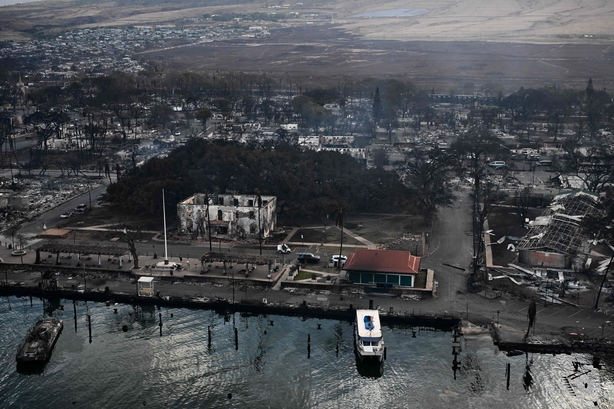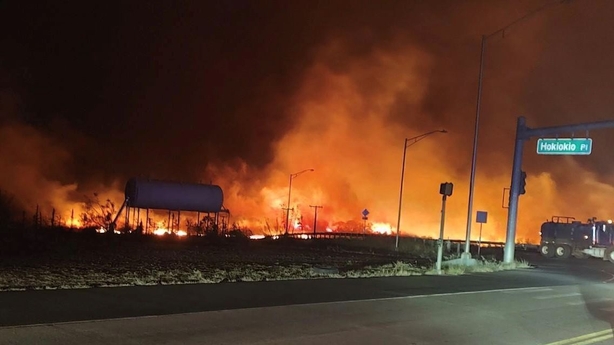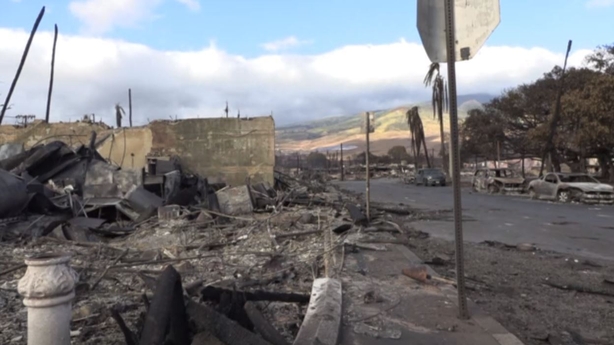The death toll from a wildfire that killed at least 59 people on Hawaii's Maui island is expected to rise, as search teams prepared to comb through the charred ruins of a historic resort town for more victims.
The inferno, which erupted on Tuesday, reduced the town of Lahaina to piles of smouldering debris as it torched 1,000 buildings, incinerated cars and left thousands homeless in what officials say is already the worst natural disaster in the state's history.
Cadaver dogs from California and Washington state will assist in the grim task of recovering human remains from the ruins as firefighters work to extinguish hot spots and smaller fires.
The fire was 80% contained as of yesterday evening, officials said.
"Understand this: Lahaina Town is hallowed, sacred ground right now," Maui Police Chief John Pelletier said, referring to human remains that have yet to be recovered. "We have to get them out."
In addition to searching for the missing, officials were drafting a plan to house the newly homeless in hotels and tourist rental properties. The island currently has four shelters in operation for the displaced.
Authorities also were dealing with widespread power and water issues across the community.
As of this morning, some 11,000 homes and businesses remained without power, according to Poweroutage.us.
Witnesses to the conflagration that hit Lahaina spoke of their terror when, without warning, the blaze consumed a town in what seemed to many of them to be a matter of minutes.
Some escaped the racing flames by jumping into the Pacific Ocean.
Questions remain about whether a siren system intended to warn residents of danger ever sounded.
Maui County Mayor Richard Bissen told NBC's "Today" show that he did not know whether the sirens went off but said the fire moved extraordinarily quickly due to powerful gusts from a hurricane passing well south of the Hawaiian archipelago.
"I think this was an impossible situation," he said.
Thousands of tourists and locals were evacuated from the western side of Maui, which has a year-round population of about 166,000, some taking shelter on the island and other on the neighboring island of Oahu.
Tourists camped out in the Kahului Airport, waiting for flights back home.
Many more people suffered burns, smoke inhalation and other injuries.
"It was so hot all around me, I felt like my shirt was about to catch on fire," Nicoangelo Knickerbocker, a 21-year-old resident of Lahaina, said from one of the four emergency shelters opened on the island.
He heard cars and a gas station explode, and soon after fled the town with his father, bringing with them only the clothes they were wearing and the family dog.
"It sounded like a war was going on," he said.
Governor Josh Green said the scope of the disaster would surpass that of 1960, one year after Hawaii became a US state, when a tsunami killed 61 people on the Big Island of Hawaii.
"It's going to take many years to rebuild Lahaina," Mr Green said at a news conference.
Lahaina, the former capital of the Kingdom of Hawaii, is known for its historical and cultural significance, and as such is a major tourist destination.
The 200-year-old Waiola Church was among the structures destroyed by the fire, local media reported.
The landmark was the focal point of Christianity on Maui and the burial site of early members of the royal family, according to the church's website.
The fate of some of Lahaina's other treasures remains unclear.
An 18-metre-tall banyan tree marking the spot where Hawaiian King Kamehameha III's 19th-century palace stood was still standing after the fire swept through the town, though some of its boughs appeared charred, according to a witness.
The Maui blazes are the latest wildfires that have struck this summer around the globe.

and buildings burned to the ground in Lahaina
Fires forced tens of thousands of people in Greece, Spain, Portugal and other parts of Europe to evacuate, while in western Canada smoke from a series of severe fires blanketed a vast swath of the US Midwest and East Coast.
In a typical year, wildfires char less than 1% of Hawaii's acreage, about the same as other US states.
But the spread of non-native, fire-prone grasses on former farmland around towns and a warming climate have elevated the threat of wildfires on the islands, according to the Hawaii Wildfire Management Organization.
Read more
Like a warzone: Hawaii's fleeing tourists tell of escape
How did the Hawaii wildfires start?
Mick Fleetwood's restaurant burned down in wildfires
What are the challenges facing aid workers?
Gregory Knickerbocker, Nicoangelo Knickerbocker's father, described in an interview how the fire barreled toward the town through dry grass fields where sugar cane was once cultivated.
The Lahaina fire is one of three major wildfires on Maui. As of yesterday evening, it was 80% contained, while the Pulehu fire, burning to the east, was 70% contained.
There was no estimate for the Upcountry fire in the centre of the eastern mass of the island, Maui County said.
On a positive note, the powerful wind gusts that had fanned the fires earlier in the week were forecast to ease to 9.7kph today, helping efforts by firefighters to secure the fire perimeters.

The Hawaii fires follow other extreme weather events this summer in North America, with record-breaking wildfires still burning across Canada and a major heat wave baking the US southwest.
Europe and parts of Asia have also endured soaring temperatures, with major fires and floods wreaking havoc.
As global temperatures rise over time, heatwaves are projected to become more frequent, with increased dryness due to changing rainfall patterns creating ideal conditions for bush or forest fires.
Ciaran Nugent, a regional inspector with the forestry service and a board member of the International Association of Wildland Fire said the level, scale and intensity of wildfires is increasing, which is in line with climate change projections.
Speaking on RTÉ's Morning Ireland, he said the fires were leading to tragic outcomes.
Mr Nugent said: "The climate projections, the IPPC report have all shown this, and science has predicted this, and we are seeing that now playing out in landscapes.
"Absolutely tragic outcomes here in terms of the loss of life, the scale of this.
"We've seen this unfortunately in lots of different landscapes, lots of different countries in the last few years and the systems and the structures we have for dealing with these types of disasters are now changing to adapt to this."

Mr Nugent said some fires are difficult to control due to the location and a particular mixture of factors.
He said: "Fires have many different factors, it's not just the fire and the wind, there's a lot of landscape level factors involved.
"The vegetation, the type of vegetation, the flammability, the region that the fire takes place in."
He also said the make-up of housing and the structures involved can also be a factor and the mixture of factors are catastrophic when fire is brought into the mix.
He said about 30% of fire outcomes are related to climate itself and the fires themselves are now climate contributors in their own right.
"For example, in Canada this season, we've seen 5,500 fires since June, and they've burned 13.5 million hectares approximately.
"That's about 4% of the forest cover of Canada and the net output of those in terms of climate emissions is about 290 million tonnes of carbon, so that's a huge amount. That's almost half of Canada's total carbon output."

